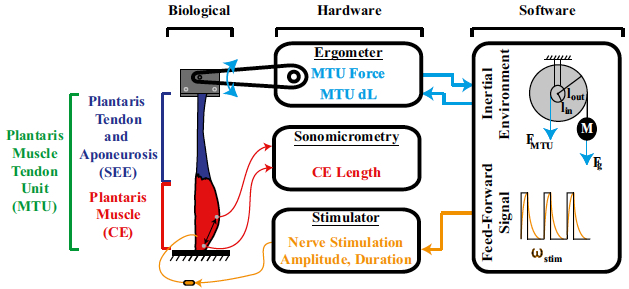Hybrid bio-robotic system models physics of human leg locomotion
October 14, 2015

Schematic of bio-robotic modeling system (credit: Benjamin D. Robertson and Gregory S. Sawicki/PNAS)
North Carolina State University (NC State) researchers have developed a bio-inspired system that models how human leg locomotion works, by using a computer-controlled nerve stimulator (acting as the spinal cord) to activate a biological muscle-tendon.
The findings could help design robotic devices that begin to merge human and machine to assist human locomotion, serving as prosthetic systems for people with mobility impairments or exoskeletons for increasing the abilities of able-bodied individuals.
The model is based on the natural spring-like physics (mass, stiffness, and leverage) of the ankle’s primary muscle-tendon unit (using a bullfrog’s muscle). The system used a feedback-controlled servomotor, simulating the inertial/gravitational environment of terrestrial gait.
Tuning for natural resonance
The research showed that the natural resonance* of the system is a likely mechanism behind springy leg behavior during locomotion, according to Gregory Sawicki, associate professor at NC State and University of North Carolina at Chapel Hill Joint Department of Biomedical Engineering. He is also co-author of a paper on the work published in Proceedings of the National Academy of Sciences.
In this case, the electrical system — the body’s nervous system — drives the mechanical system (the leg’s muscle-tendon unit) at a frequency that provides maximum power output.
The researchers found that by matching the stimulation frequency to the natural resonance frequency of the passive biomechanical system, muscle-tendon interactions (resulting in spring-like behavior) occur naturally and do not require closed-loop neural control — simplifying system design.
“In locomotion, resonance comes from tuning the interaction between the nervous system and the leg so they work together,” said Sawicki. “It turns out that if I know the mass, leverage, and stiffness of a muscle-tendon unit, I can tell you exactly how often I should stimulate it to get resonance in the form of spring-like, elastic behavior.”
“In the end, we found that the same simple underlying principles that govern resonance in simple mechanical systems also apply to these extraordinarily complicated physiological systems,” said Temple University post-doctoral researcher Ben Robertson, corresponding author of the paper.
“This outcome points to mechanical resonance as an underlying principle governing muscle-tendon interactions and provides a physiology-based framework for understanding how mechanically simple elastic limb behavior may emerge from a complex biological system comprised of many simultaneously tuned muscle-tendons within the lower limb,” the researchers conclude in the paper.
* NC State biomedical engineer Greg Sawicki likened resonance tuning to interacting with a slinky toy. “When you get it oscillating well, you hardly have to move your hand — it’s the timing of the interaction forces that matters.
Abstract of Unconstrained muscle-tendon workloops indicate resonance tuning as a mechanism for elastic limb behavior during terrestrial locomotion
In terrestrial locomotion, there is a missing link between observed spring-like limb mechanics and the physiological systems driving their emergence. Previous modeling and experimental studies of bouncing gait (e.g., walking, running, hopping) identified muscle-tendon interactions that cycle large amounts of energy in series tendon as a source of elastic limb behavior. The neural, biomechanical, and environmental origins of these tuned mechanics, however, have remained elusive. To examine the dynamic interplay between these factors, we developed an experimental platform comprised of a feedback-controlled servo-motor coupled to a biological muscle-tendon. Our novel motor controller mimicked in vivo inertial/gravitational loading experienced by muscles during terrestrial locomotion, and rhythmic patterns of muscle activation were applied via stimulation of intact nerve. This approach was based on classical workloop studies, but avoided predetermined patterns of muscle strain and activation—constraints not imposed during real-world locomotion. Our unconstrained approach to position control allowed observation of emergent muscle-tendon mechanics resulting from dynamic interaction of neural control, active muscle, and system material/inertial properties. This study demonstrated that, despite the complex nonlinear nature of musculotendon systems, cyclic muscle contractions at the passive natural frequency of the underlying biomechanical system yielded maximal forces and fractions of mechanical work recovered from previously stored elastic energy in series-compliant tissues. By matching movement frequency to the natural frequency of the passive biomechanical system (i.e., resonance tuning), muscle-tendon interactions resulting in spring-like behavior emerged naturally, without closed-loop neural control. This conceptual framework may explain the basis for elastic limb behavior during terrestrial locomotion.